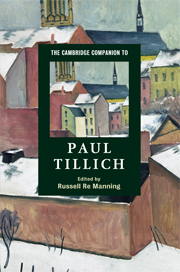Book contents
- Frontmatter
- Part I Standing within the theological circle
- 1 Tillich’s life and works
- 2 Tillich as systematic theologian
- 3 Tillich on God
- 4 Tillich’s Christology
- 5 Tillich’s theology of the concrete spirit
- 6 Faith (and religion)
- 7 ‘First, read my sermons’ Tillich as preacher
- Part II Theology of culture
- Part III Tillich in dialogue
- Bibliography
- Index
4 - Tillich’s Christology
from Part I - Standing within the theological circle
Published online by Cambridge University Press: 28 May 2009
- Frontmatter
- Part I Standing within the theological circle
- 1 Tillich’s life and works
- 2 Tillich as systematic theologian
- 3 Tillich on God
- 4 Tillich’s Christology
- 5 Tillich’s theology of the concrete spirit
- 6 Faith (and religion)
- 7 ‘First, read my sermons’ Tillich as preacher
- Part II Theology of culture
- Part III Tillich in dialogue
- Bibliography
- Index
Summary
Throughout his life Tillich grappled with the problem of history. Very early on he cleared a speculative space by asserting that there need be no historical certainty concerning the actual life of Jesus of Nazareth. Later he wrote: 'faith does guarantee the factual transformation of reality in that personal life which the New Testament expresses in its picture of Jesus as the Christ' (ST II, 107). If there is indeed a dividing line in Western theology between those who ask the modern or 'liberal' question of Jesus' place in our story and other theologians - postmodern or pre-modern- who choose to enquire only 'into our place in his', Tillich certainly belongs to the former. Another aspect of Tillich's engagement with history is his keen sense of theologians' double allegiance: to their own time and to the 'eternal' message. Finally, history is intimately bound up with theology because the New Being was received in 'preparatory' events. From the death of Jesus and the birth of Christians, 'history is transformed and you and I are no more, and should not be any more, what we were before' (NB, 179). When English-speaking readers of Tillich look for a complete account of his Christology, many will reach for the third part of the Systematic Theology, 'Existence and the Christ', which constitutes the second of three volumes. Simultaneously with the academic Christology of the mature theologian, a narrative and poetic version came into being, namely the second volume of Tillich's American sermons, The New Being. A third group of texts is the (much) earlier writings of the German period, starting from 1911.
- Type
- Chapter
- Information
- The Cambridge Companion to Paul Tillich , pp. 56 - 73Publisher: Cambridge University PressPrint publication year: 2009
- 1
- Cited by

